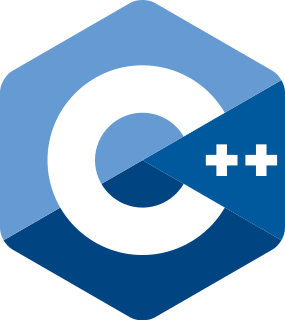In programming, operator overloading, sometimes termed operator ad hoc polymorphism, is a specific case of polymorphism, where different operators have different implementations depending on their arguments. Operator overloading is generally defined by a programming language, a programmer, or both.
In object-oriented and functional programming, an immutable object is an object whose state cannot be modified after it is created. This is in contrast to a mutable object, which can be modified after it is created. In some cases, an object is considered immutable even if some internally used attributes change, but the object's state appears unchanging from an external point of view. For example, an object that uses memoization to cache the results of expensive computations could still be considered an immutable object.
In mathematics and computer science, a higher-order function is a function that does at least one of the following:
Type inference refers to the automatic detection of the data type of an expression in a programming language.
In computer science, a type signature or type annotation defines the inputs and outputs for a function, subroutine or method. A type signature includes the number of arguments, the types of arguments and the order of the arguments contained by a function. A type signature is typically used during overload resolution for choosing the correct definition of a function to be called among many overloaded forms.
In computer programming, a parameter or a formal argument, is a special kind of variable, used in a subroutine to refer to one of the pieces of data provided as input to the subroutine. These pieces of data are the values of the arguments with which the subroutine is going to be called/invoked. An ordered list of parameters is usually included in the definition of a subroutine, so that, each time the subroutine is called, its arguments for that call are evaluated, and the resulting values can be assigned to the corresponding parameters.
The syntax of the C programming language, the rules governing writing of software in the language, is designed to allow for programs that are extremely terse, have a close relationship with the resulting object code, and yet provide relatively high-level data abstraction. C was the first widely successful high-level language for portable operating-system development.
In computer programming, a function object is a construct allowing an object to be invoked or called as if it were an ordinary function, usually with the same syntax. Function objects are often called functors.
In computer programming, ?: is a ternary operator that is part of the syntax for basic conditional expressions in several programming languages. It is commonly referred to as the conditional operator, inline if (iif), or ternary if. An expression a? b : c evaluates to b if the value of a is true, and otherwise to c.
In computer programming, a function prototype or function interface is a declaration of a function that specifies the function's name and type signature, but omits the function body. While a function definition specifies how the function does what it does, a function prototype merely specifies its interface, i.e. what data types go in and come out of it. The term function prototype is particularly used in the context of the programming languages C and C++ where placing forward declarations of functions in header files allows for splitting a program into translation units, i.e. into parts that a compiler can separately translate into object files, to be combined by a linker into an executable or a library.
In the C, C++, D, and JavaScript programming languages, const is a type qualifier: a keyword applied to a data type that indicates that the data is read only. While this can be used to declare constants, const in the C family of languages differs from similar constructs in other languages in being part of the type, and thus has complicated behavior when combined with pointers, references, composite data types, and type-checking.
The computer programming languages C and Pascal have similar times of origin, influences, and purposes. Both were used to design their own compilers early in their lifetimes. The original Pascal definition appeared in 1969 and a first compiler in 1970. The first version of C appeared in 1972.
In the C programming language, data types are declarations for memory locations or
variables that determine the characteristics of the data that may be stored and the methods (operations) of processing that are permitted involving them.
typedef is a reserved keyword in the C and C++ programming languages. It is used to create an alias name for another data type. As such, it is often used to simplify the syntax of declaring complex data structures consisting of struct and union types, but is just as common in providing specific descriptive type names for integer data types of varying lengths.
XL stands for eXtensible Language. It is the first and so far the only computer programming language designed to support concept programming.
A class in C++ is a user defined type or data structure declared with keyword class that has data and functions as its members whose access is governed by the three access specifiers private, protected or public. The private members are not accessible outside the class; they can be accessed only through methods of the class. The public members form an interface to the class and are accessible outside the class.
C++11 is a version of the standard for the programming language C++. It was approved by International Organization for Standardization (ISO) on 12 August 2011, replacing C++03, superseded by C++14 on 18 August 2014 and later, by C++17. The name follows the tradition of naming language versions by the publication year of the specification, though it was formerly named C++0x because it was expected to be published before 2010.
This article describes the syntax of the C# programming language. The features described are compatible with .NET Framework and Mono.
In computer programming, a subroutine is a sequence of program instructions that performs a specific task, packaged as a unit. This unit can then be used in programs wherever that particular task should be performed.
In the C, C++, and D programming languages, a type qualifier is a keyword that is applied to a type, resulting in a qualified type. For example, const int is a qualified type representing a constant integer, while int is the corresponding unqualified type, simply an integer. In D these are known as type constructors, by analogy with constructors in object-oriented programming.


